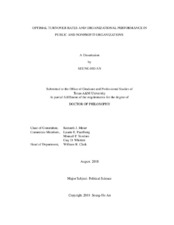| dc.description.abstract | Until recent years, most public and nonprofit management studies have focused on the
determinants of turnover rather than the consequences. In this line of literature, a better
theory of turnover for public and nonprofit organizations, especially the one focused on
outcomes of turnover, is needed. This dissertation seeks to advance our knowledge on the
issues of turnover and organizational performance in public and nonprofit management.
Using the three-paper model, the dissertation not only develops a theoretical model on
turnover and performance, but also conduct empirical testing on how turnover affects the
performance of public and nonprofit organizations.
Specifically, the first essay presents an economic model based on turnover
cost-benefit theories by incorporating labor market conditions and quality of employees,
which can be applied regardless of sector and industry. To do so, I re-evaluate turnover
and retention costs that change according to employee quality and labor supply and
demand. I also propose several testable hypotheses for future scholars, which enable them
to examine under what conditions the optimal rates of turnover change and how public
managers would benefit from an occurrence of turnover. The second essay investigates
the effects of employee turnover on organizational performance in Florida school
districts, distinguishing types of turnover as voluntary and involuntary. In the essay, I find
an inverted-U shaped relationship between involuntary turnover and organizational
performance, first positive and then negative. The last essay tests an inverted-U shaped
relationship in the context of the United Way nonprofit organizations. Findings suggest
that governing board turnover rates have a nonlinear effect on nonprofit financial
capacity, first positive and then negative. Taken together, both theoretical and empirical
investigations in this dissertation suggest that optimal turnover rates exist and that those
can vary by sector. The findings provide an important lesson for both scholars and
practitioners that turnover should be appropriately managed, not necessarily minimized. | en |


